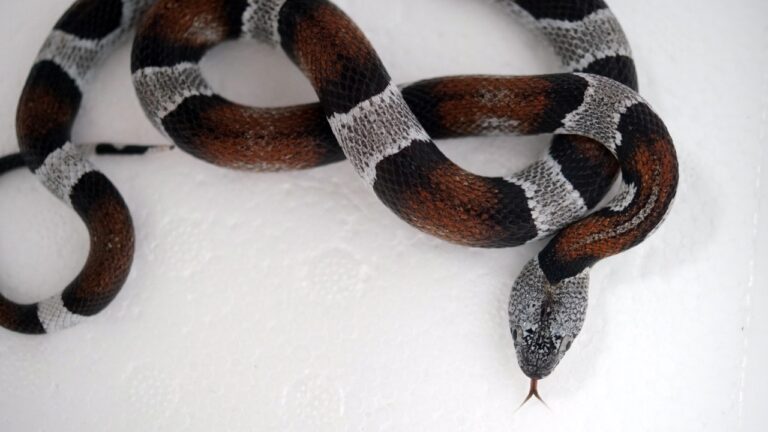Understanding Snake Septicemia: A Guide for Reptile Enthusiasts
Overview of Snake Septicemia
Snake septicemia is a serious condition that can have devastating effects on our slithering companions. It is crucial for reptile enthusiasts to have a comprehensive understanding of this ailment in order to provide the best care for their scaly friends. Septicemia, also known as blood poisoning, occurs when bacteria, fungi, or viruses enter the bloodstream and spread throughout the body, wreaking havoc on various organs and systems.
As reptiles, snakes are particularly susceptible to septicemia due to their unique physiology. These cold-blooded creatures rely on external heat sources to regulate their body temperature, which can sometimes compromise their immune system. When pathogens invade their bodies, the consequences can be dire. Snake septicemia can manifest in a variety of ways, depending on the type of infection and the organs affected.
In this article, we will delve into the intricacies of snake septicemia, exploring its definition, causes, symptoms, diagnosis, and treatment options. We will also discuss preventive measures that can be taken to minimize the risk of infection and promote overall snake health. So, buckle up and get ready to embark on a journey through the fascinating realm of snake septicemia. Together, we will unravel its mysteries and equip ourselves with the knowledge needed to protect our scaly companions.
What is Snake Septicemia?
Snake septicemia is a serious condition that can affect reptiles, particularly snakes. It is characterized by a systemic infection that spreads throughout the snake’s body, leading to a range of debilitating symptoms. Understanding the causes, symptoms, and treatment options for snake septicemia is crucial for reptile enthusiasts who want to keep their beloved pets healthy and thriving.
Definition and Causes
Snake septicemia, also known as septicemic syndrome, is an infection that occurs when bacteria, fungi, or viruses enter a snake’s bloodstream. This can happen through open wounds, contaminated food or water, or even through the respiratory system. Once the pathogens enter the bloodstream, they can rapidly multiply and spread, wreaking havoc on the snake’s immune system and vital organs.
There are several factors that can contribute to the development of snake septicemia. Poor hygiene and sanitation practices can create an environment conducive to bacterial or fungal growth. Additionally, stress, overcrowding, and inadequate nutrition can weaken a snake’s immune system, making it more susceptible to infections. It is important for snake owners to maintain a clean and stress-free environment for their pets to minimize the risk of septicemia.
Common Symptoms
Identifying the symptoms of snake septicemia is crucial for early detection and prompt treatment. While the specific symptoms may vary depending on the underlying cause of the infection, there are some common signs to look out for. These include:
- Loss of appetite: A snake with septicemia may lose interest in food and exhibit a decreased appetite.
- Lethargy: Infected snakes may become lethargic, spending more time hiding and exhibiting a lack of energy.
- Abnormal behavior: Changes in behavior, such as increased aggression or unusually subdued behavior, can indicate a health issue.
- Skin discoloration: The snake’s skin may appear discolored, showing signs of redness, bruising, or blotches.
- Respiratory problems: Labored breathing, wheezing, or coughing are common respiratory symptoms associated with septicemia.
- Swollen or ulcerated skin: In severe cases, the snake’s skin may develop ulcers or become swollen due to the infection.
Diagnosis and Treatment
Diagnosing snake septicemia requires a thorough examination by a reptile veterinarian. The veterinarian will conduct a physical examination and may also perform additional tests, such as blood work and culture analysis, to identify the specific pathogen causing the infection. This information is crucial for determining the most effective treatment plan.
Treatment for snake septicemia typically involves a combination of veterinary care, medications, and supportive care. The veterinarian may prescribe antibiotics or antifungal medications to combat the infection. It is important to follow the prescribed treatment regimen carefully and complete the full course of medication to ensure the eradication of the infection.
In addition to medication, supportive care is essential for aiding the snake’s recovery. This may include providing a clean and stress-free environment, maintaining proper hydration and nutrition, and monitoring the snake’s progress closely. Regular check-ups with the veterinarian are important to assess the snake’s response to treatment and make any necessary adjustments.
By understanding the definition, causes, symptoms, and treatment options for snake septicemia, reptile enthusiasts can take proactive steps to prevent and manage this serious condition. Prioritizing proper hygiene and sanitation, along with regular veterinary check-ups and a balanced diet, can go a long way in promoting the well-being of snakes and minimizing the risk of septicemia. Remember, a healthy snake is a happy snake!
Types of Snake Septicemia
When it comes to snake health, it is crucial for reptile enthusiasts to be aware of the various types of snake septicemia. This condition can be caused by bacterial infections, fungal infections, or viral infections, each with its own set of characteristics and treatment approaches.
Bacterial Infections: Bacterial infections are one of the most common causes of snake septicemia. These infections can occur when harmful bacteria enter a snake’s bloodstream, leading to a wide range of symptoms and potential complications. Some common bacterial infections in snakes include snake scale rot and snake mouth rot. These infections can result from poor hygiene, improper handling, or even a weakened immune system. It is essential to identify and treat bacterial infections promptly to prevent further complications.
Fungal Infections: Fungal infections can also contribute to snake septicemia. These infections often occur when snakes are exposed to damp or unsanitary conditions, which create an ideal environment for fungi to thrive. Snakes with compromised immune systems are particularly susceptible to fungal infections. Common fungal infections in snakes include snake mites treatment and snake inclusion body disease. These infections can cause severe damage to a snake’s respiratory system, skin, and organs if left untreated.
Viral Infections: Viral infections, although less common, can also lead to snake septicemia. These infections can be highly contagious and often cause severe symptoms and potentially fatal outcomes. Some viral infections that snakes may be susceptible to include snake respiratory infection, snake prolapse treatment, and snake shedding problems. These infections can weaken a snake’s immune system, making them more vulnerable to other diseases and complications.
Understanding the different types of snake septicemia is vital for reptile enthusiasts to ensure the well-being and health of their scaly companions. By recognizing the signs and symptoms associated with each type of infection, owners can seek veterinary care promptly and provide the appropriate medications and antibiotics to combat the infection. Additionally, practicing proper hygiene, regular check-ups, and a balanced diet can help prevent the occurrence of snake septicemia and promote overall snake health.
In the next section, we will delve deeper into the prevention strategies that can be implemented to safeguard snakes from acquiring septicemia.
Stay tuned for the next installment!
Preventing Snake Septicemia
When it comes to the health and well-being of our scaly friends, prevention is always better than cure. This holds especially true for snake septicemia, a potentially serious condition that can affect our beloved reptiles. By taking a proactive approach and implementing preventive measures, we can significantly reduce the risk of snake septicemia and ensure the longevity of our slithering companions.
Proper Hygiene and Sanitation
Maintaining a clean and hygienic environment is of paramount importance in preventing snake septicemia. Regularly cleaning and disinfecting the snake’s enclosure, including the substrate, water bowls, and any decorations, helps to eliminate harmful bacteria, fungi, and viruses that can lead to septicemia. Using appropriate disinfectants that are safe for reptiles is crucial to strike a balance between cleanliness and the health of our scaly friends.
Quarantine and Regular Check-ups
One of the most effective ways to prevent snake septicemia is to implement a strict quarantine protocol for any new additions to your reptile collection. This practice helps to identify and isolate any potential carriers of infectious diseases, including septicemia, before they have the chance to spread to other snakes. Regular check-ups with a reptile veterinarian are also essential to catch any signs of septicemia early on. A professional eye can detect subtle symptoms that may go unnoticed by even the most attentive reptile enthusiast.
Balanced Diet and Nutrition
A healthy and well-balanced diet is not only crucial for the overall well-being of a snake but also plays a vital role in preventing septicemia. Providing a diet that meets the specific nutritional needs of your snake ensures a robust immune system, making it less susceptible to infections. Including a variety of prey items that are appropriate for your snake’s species and size helps to ensure that all essential nutrients are being met. Adequate hydration is equally important, as it helps in the proper functioning of the immune system and the elimination of toxins from the body.
By following these preventive measures, you are not only reducing the risk of snake septicemia but also promoting the overall health and happiness of your scaly companion. Remember, prevention is key in keeping your snake thriving and free from the clutches of septicemia.
For more information on other common snake health issues and their treatments, feel free to explore our articles on snake scale rot or snake mouth rot.
Treating Snake Septicemia
When it comes to the treatment of snake septicemia, veterinary care is of utmost importance. Seeking professional help from a veterinarian who specializes in reptile medicine is crucial for the well-being and recovery of your snake.
Upon diagnosis, the veterinarian will develop a tailored treatment plan based on the severity of the infection and the type of medications and antibiotics that are most effective against the specific bacteria, fungus, or virus causing the septicemia. These medications may be administered orally, topically, or through injections, depending on the situation.
It is important to follow the veterinarian’s instructions carefully and complete the full course of medication prescribed, even if the snake’s symptoms improve. This ensures that the infection is fully eradicated and reduces the risk of recurrence or the development of antibiotic resistance.
In addition to medications, supportive care plays a vital role in the treatment process. This includes providing a clean and comfortable habitat for the snake to aid in its recovery. Maintaining proper temperature and humidity levels, ensuring adequate ventilation, and minimizing stress are crucial factors in supporting the snake’s immune system.
Furthermore, it is essential to monitor the snake closely for any changes in behavior, appetite, or appearance during the treatment period. Regular check-ups with the veterinarian will allow for the evaluation of the snake’s progress and adjustments to the treatment plan if necessary.
Remember, snake septicemia can be a serious and potentially life-threatening condition. Prompt and appropriate treatment is essential for the best chances of recovery. Seeking professional veterinary care, administering prescribed medications, and providing proper supportive care are all integral components in the battle against this infection.
Stay vigilant and proactive in your snake’s health to prevent future occurrences of snake septicemia, as well as other common snake ailments such as snake scale rot, snake mouth rot, snake mites, snake inclusion body disease, snake respiratory infection, snake prolapse, snake shedding problems, snake kidney disease, and snake neurological disorders. By taking a proactive approach, you can ensure the well-being and longevity of your scaly friend.
For more information on specific snake ailments and their treatments, feel free to explore our comprehensive articles on SerpentSuppers.com.
Conclusion
In conclusion, understanding snake septicemia is crucial for reptile enthusiasts who are dedicated to the well-being of their scaly companions. By delving into the intricacies of this condition, one can equip themselves with the knowledge necessary to prevent, diagnose, and treat snake septicemia effectively.
Snake septicemia, as we have explored, encompasses various types of infections, including bacterial, fungal, and viral. Identifying the underlying cause of the infection is vital in delivering the appropriate treatment. Regular check-ups and quarantine measures can aid in early detection, allowing for timely intervention.
Maintaining proper hygiene and sanitation practices is paramount in preventing the onset of snake septicemia. By keeping enclosures clean and providing a balanced diet, reptile owners can bolster their snakes’ immune systems and minimize the risk of infection.
When faced with a suspected case of snake septicemia, seeking veterinary care is essential. Veterinarians possess the expertise to diagnose the condition accurately and prescribe the appropriate medications and antibiotics. In conjunction with medical treatment, providing supportive care, such as maintaining optimal temperature and humidity levels, can aid in the recovery process.
It is important to note that snake septicemia is just one of the many health concerns that reptile enthusiasts should be aware of. Other conditions, such as snake scale rot, snake mouth rot, snake mites, snake inclusion body disease, snake respiratory infection, snake prolapse, snake shedding problems, snake kidney disease, snake neurological disorders, and snake infectious stomatitis, can also affect the well-being of these captivating creatures. Therefore, it is crucial to stay informed and take proactive measures to ensure the health and happiness of our slithering companions.
In conclusion, by adopting a diligent approach to snake care and staying vigilant for any signs of infection, reptile enthusiasts can create a safe and healthy environment for their beloved snakes. Through education, preventative measures, and timely treatment, snake septicemia can be effectively managed, allowing these magnificent creatures to thrive in our care. So, let us continue to nurture our reptilian friends and celebrate the wonder they bring to our lives.







